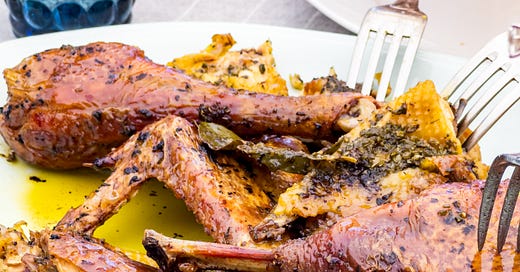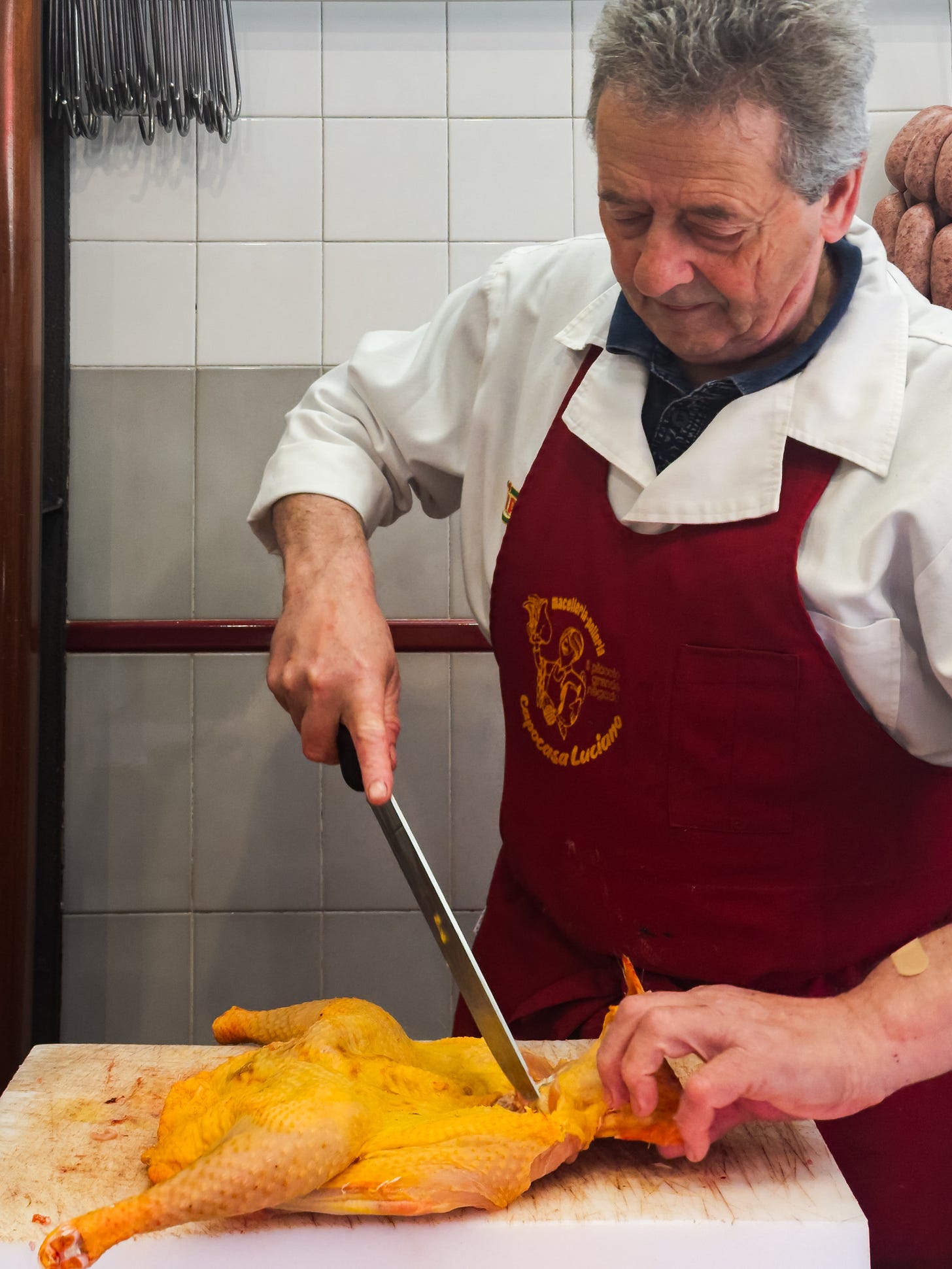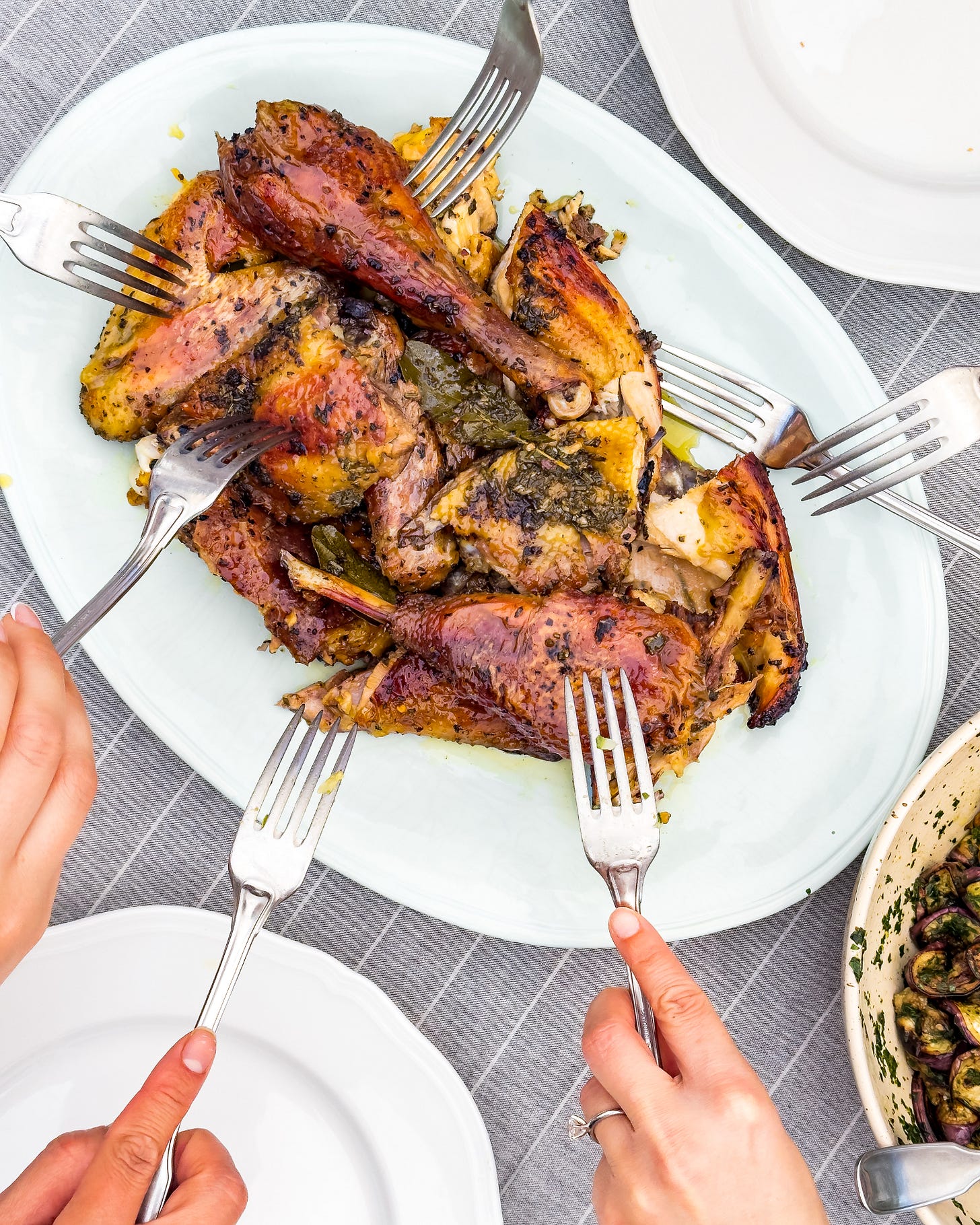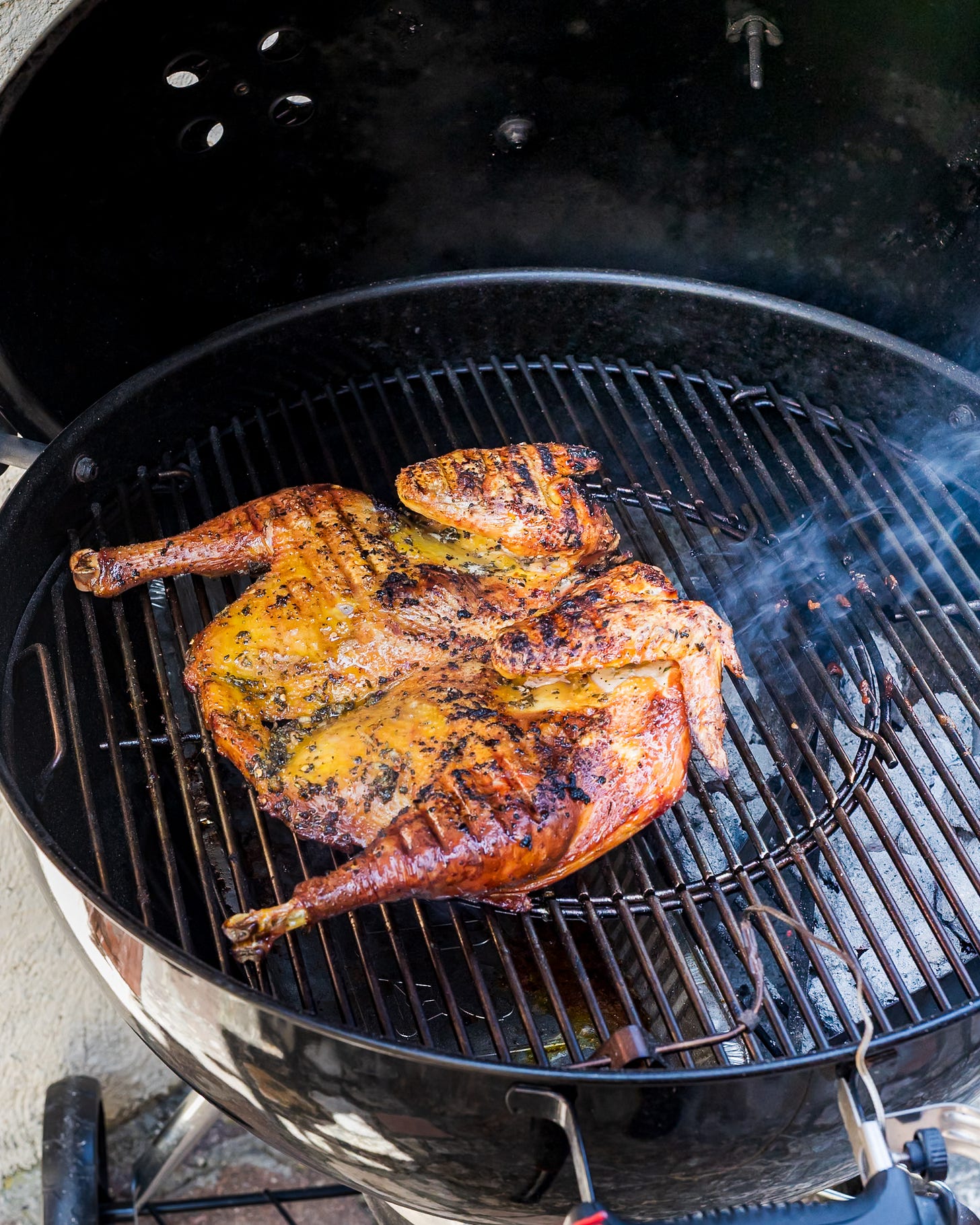"Pollo al Mattone": Tuscan Brick-roast Spatchcocked Chicken.
Today, I’m passing the apron to Giulia Scarpaleggia, a Tuscan food writer, who shares her family’s cherished recipe for traditional Tuscan roast chicken.
Today, I’m absolutely delighted to open up my kitchen to someone I’ve long admired—Giulia Scarpaleggia, a gifted and passionate cook from Tuscany—so she can share with you a little slice of her world, along with one of her cherished family recipes, Pollo Al Mattone.
I first discovered Giulia years ago through her blog, Juls’ Kitchen, and was instantly hooked. Her gift for storytelling and her down-to-earth, flavorful recipes drew me in immediately. From there, I fell deeper into her world through her vibrant Instagram feed and her thoughtful podcast, Cooking with an Italian accent. Every piece of content she shares makes you feel as if you’ve stepped into her family’s warm Tuscan kitchen—browsing the local market, learning age-old cooking techniques, and enjoying the simple joys of home-cooked meals.
What I love most about Giulia is her ability to capture the soul of everyday Tuscan life—honest, humble, and deeply connected to tradition. Her recipes, photos, stories, and even her postcards are all woven with such vivid sincerity that they transport you beyond the clichés of Italian cuisine, straight into something real and deeply personal.
When she launched her Substack a few years ago, I became even more of a devotee. Her words always strike a chord with me—especially because I often find parallels between Tuscan and Breton cooking: two regional traditions rooted in peasant wisdom, seasonal ingredients, and a love for humble, honest food—far from the polished stereotypes often seen outside of France and Italy.
So when Giulia and I began talking about the idea of exchanging recipes for our readers, we were immediately drawn to the idea of exploring a Sunday roast chicken—the ultimate family meal, steeped in tradition on both sides. And while the Breton and Tuscan versions differ in ingredients and technique, each tells its own beautiful story and results in something comforting, succulent, and meant to be shared.
Earlier this week, I shared my Breton Roast Chicken recipe with you—and now, it’s time to pass the apron to Giulia, who’s here to share her classic Tuscan version: Pollo al Mattone.
I hope you enjoy stepping into her kitchen as much as I always do.
Bon appétit,
Buongiorno from Tuscany! I’m Giulia Scarpaleggia, a Tuscan-born and bred food writer, cookbook author, and cooking class instructor. I grew up in the countryside between Siena and Florence, and—just like in the best clichés—I learned to cook at my grandmother’s side, falling in love early on with the honest, seasonal rhythms of Italian home cooking.
After studying Marketing and Communication at university, I fell head over heels for food. The kitchen became my safe harbour; cooking, my favourite way to express love, make friends, and tell stories. I learned the craft one burnt tray of biscuits at a time, kneading bread that could double as a doorstop, and slowly building confidence through family recipes and my ever-growing cookbook collection.
My journey began in 2009 with Juls’ Kitchen, a bilingual blog in English and Italian, where I’ve been sharing recipes and stories ever since. I’ve written six cookbooks, including Cucina Povera (2023), and for the past fifteen years, I’ve been teaching Tuscan cooking classes in our countryside home alongside my husband and photographer, Tommaso. In 2021, we launched Letters from Tuscany, a weekly newsletter where I celebrate the timeless beauty of regional Italian food and share seasonal recipes, stories, travel tips, and glimpses of our daily life in a Tuscan cooking school.
Though my heart belongs to cucina povera, I’ve always admired the elegance, technique, and seasonality of French cuisine. It’s a true pleasure to share with you today this rustic pollo al mattone — Tuscan brick-roast spatchcocked chicken — a dish that bridges our two culinary worlds.
In many ways, pollo al mattone embodies the essence of Tuscan cooking: it is simple, rustic, deeply flavoured, and built on good extra virgin olive oil. Where French cuisine often begins with butter, we begin with oil: grassy, golden, generous. Extra virgin olive oil, for us, isn’t just an ingredient. It is closer to a religion.
We pour it into marinades, massage it into meat, and finish every dish with a generous drizzle that feels almost like a blessing.
“The best chickens in Italy come from Tuscany. A young, plump chicken of the Valdarno grilled in butter on a charcoal fire is a lovely dish of the simplest kind.”
- Elizabeth Davis, Italian Food, 1954
The Sunday meal begins at the butcher’s.
I linger by the counter, letting my eyes wander in search of inspiration — perhaps a classic arista alla fiorentina, that beautifully simple Tuscan roast pork loin, or maybe a tender rosbiffe, as we call roast beef here, something my five-year-old daughter would happily devour.
Then I spot the chickens: smallish, with a golden-yellow skin that seems to glow under the lights. Luciano, my butcher, notices my gaze. With a knowing smile, he picks one up and launches into a familiar story — about these birds, raised the old-fashioned way by an 85-year-old farmer on a tiny family-run fattoria near Montaione.
“They roam free in the fields,” he says proudly, “fed on good food, just like your neighbour used to do. Remember him?” He’s already deep into stories of the past, but my mind is elsewhere, already turning over ideas for how to cook the chicken.
That’s when I glance over at Stefania, Luciano’s wife, busy butterflying a turkey breast for another customer. I owe her more than I can say: most of my best meat dishes are thanks to her. She has taught me how to choose the right cut for spezzatino, how to tenderise a veal cutlet, how to stuff a deboned rabbit or a whole chicken, and just how long to roast pork ribs until they’re fall-apart tender.
“Stefania, what should I do with this chicken? Roast it? Maybe al tegame, with a bit of tomato sauce?”
Without missing a beat, she calls back over the counter: “Fallo al mattone! Roast it under a brick! and, Luciano, why don’t you spatchcock it for Giulia while we’re at it?”
Pollo al mattone or pollo alla diavola?
Once the chicken has been spatchcocked, you actually have two splendid options. Whether you’re craving something spicy and bold, or golden and herb-perfumed, Tuscany has you covered.
One option is pollo alla diavola, or Devil’s-style chicken. According to Pellegrino Artusi, the father of Italian cuisine and author of La Scienza in Cucina e l’Arte di Mangiar Bene (1891):
“Si chiama così perché si dovrebbe condire con pepe forte di Caienna e servire con una salsa molto piccante, cosicché, a chi lo mangia, nel sentirsi accendere la bocca, verrebbe la tentazione di mandare al diavolo il pollo e chi l'ha cucinato.”
“It is called this because it is supposed to be seasoned with strong cayenne pepper and served with a very spicy sauce, so that whoever eats it feels his mouth on fire and is tempted to send both the chicken and whoever cooked it to the devil.”
Pollo alla diavola is rubbed with olive oil and sea salt, generously dusted with cayenne, and cooked over high heat with something heavy pressing it down until the skin turns irresistibly fiery and crisp.
Then there’s pollo al mattone — literally, “brick chicken.” It’s an ancient technique, probably Etruscan in origin, where the bird is cooked under a weight, traditionally in a wood-fired oven, often inside a special clay pan with a heavy lid on top. It’s one of Tuscany’s most beloved and time-honored ways to prepare poultry.
Here, the chicken is bathed in a marinade of extra virgin olive oil, fresh lemon juice and zest, and the classic Tuscan sacred triad: sage, rosemary, and garlic. Along with these, you can also find dried oregano and a pinch of chilli pepper flakes, to add a warm note reminiscent of pollo alla diavola. The marinade makes the chicken moist and flavorful.
Both methods make the most of the spatchcocked bird and the weight pressing it down, helping it cook more quickly and evenly, and guarantee a golden, crispy skin.
More than a meal
Buying a free-range chicken, one raised on good feed and the freedom to roam under olive trees in the hills near Montaione, can be pricey. Around €35 for a main course that feeds six. But that’s just the beginning.
I always ask my butcher to set aside the offal — mostly the heart and gizzard — along with the legs for stock. The neck, however, gets special treatment. It becomes collo ripieno, a peasant Tuscan delicacy. With expert hands, my butcher removes the bones and cartilage, leaving just the skin, still attached to the head. Later, I’ll stuff it with minced beef and sausage, breadcrumbs, grated Parmigiano, parsley, and garlic. Once stitched closed, it simmers gently in chicken stock for about an hour, lending the broth a rich, meaty depth. The neck can be served warm or at room temperature, sliced thick and paired with a spoonful of mayonnaise and a few pickles. The broth makes a beautiful base: add a handful of pastina, make a soup, or a risotto.
When serving roast chicken to my family, I gather up the bones and scraps from everyone’s plates, seal them in a freezer bag, and tuck them away for another day, the base of a future stock, deep and flavorful.
As you can see, a good organic bird can stretch far when you approach it with the sustainable, respectful spirit of cucina povera.
The best side dishes
Roast potatoes—tossed with olive oil, rosemary, and sage—are a faithful companion. But when tomatoes are at their peak, I can never resist a generous salad: thick, juicy slices glistening with good olive oil, a mere splash of vinegar, and a finishing touch of torn basil leaves or a pinch of dried oregano.
My top choice, though? A wild herb salad. Some bitter leaves, a handful of walnuts for crunch, all dressed early to soften the tougher greens, and left to mellow.
And if you’ve fired up the barbecue, don’t stop at chicken. Eggplants, zucchini, and sweet peppers served at room temperature make a gorgeous and colorful spread.
RECIPE: Pollo al mattone
Serves 6
The very best pollo al mattone is, without doubt, the one roasted in a roaring wood-fired oven, nestled inside a traditional Tuscan clay pan. But since not everyone has one of those in the garden, I’ve tested two more accessible methods, and both deliver beautifully crisp, golden-skinned results.
Potentially, you can cook it in a hot pan on the stovetop, but be warned: it’s a messy business, and not for the faint-hearted. My preferred method is in the oven, using two sturdy rimmed baking trays and a brick, a simple set-up that yields consistently delicious results.
And if you’ve got a barbecue at the ready, I’ve included notes on how to take the chicken outdoors for a smoky, summer version.
INGREDIENTS:
1 spatchcocked chicken, about 2.2 kg/5 lb
120 ml/½ cup extra virgin olive oil
Juice and zest of one untreated lemon
a dozen sage leaves, finely minced
Needles from 2 rosemary sprigs, finely minced
2 cloves garlic, finely minced
½ tablespoon fine sea salt
1 teaspoon dried oregano
½ teaspoon chili pepper flakes
TOOLS:
2 rimmed baking sheets
a clean, heavy brick, or the lid of a cast iron pot
INSTRUCTIONS:
In a large shallow dish, combine the olive oil, lemon juice and zest, herbs, garlic, salt, oregano, and chili flakes. Mix with a fork, then massage the marinade all over the chicken. Lay it skin-side down in the marinade, cover with cling film, and leave to rest at room temperature for about 2 hours.
Preheat your oven to 250°C/480°F, placing the two baking trays and the brick inside. Set the trays on separate racks so they heat evenly and are easier to handle later when hot. Allow everything to heat for about 20 minutes after the oven reaches temperature.
Carefully remove the trays from the oven. Place the chicken, skin-side up, and a bit of its marinade onto one tray, then press the second tray on top. Set the brick over the top tray to weigh it down.
Transfer to the hot oven and roast for 25 minutes. Then rotate the trays (not the chicken), and cook for another 20 minutes. The skin should be a deep, burnished gold. Pierce the thickest part of the thigh — if the juices run clear, it's done. If still pinkish, roast for another 10 minutes.
Let the chicken rest for 10 minutes before carving. Serve warm, with your favourite sides.
Want to cook the chicken on a barbecue instead?
Lately, my husband has taken quite the shine to barbecuing, so naturally, we gave pollo al mattone a go on the grill. Here’s how he does it.
To start, you’ll need two heavy bricks, each wrapped in foil to keep things clean and heat-conductive.
Prepare your barbecue for indirect cooking, aiming for a steady 180°C/ 350°F. Let it heat for about an hour, with the bricks inside so they’re piping hot when needed. If you’d like to add a touch of smoke, soak a few handfuls of wood chips in water during this time.
Once everything’s ready, lay the spatchcocked chicken skin-side up on the grill. Gently place the hot bricks on top — carefully, so they sit evenly and don’t shift. If you have a meat thermometer, insert it into the thickest part of the thigh. Scatter in the soaked wood chips if using.
Close the lid and cook the chicken at a steady temperature for about an hour, checking occasionally.
When the internal temperature hits 70°C/160°F, take off the bricks and switch to direct heat. Flip the chicken skin-side down and grill for about 10 minutes, just long enough to get that gorgeous, golden crisp, with pronounced grill marks.
Lift the chicken off the grill, transfer it to a tray, and cover it loosely with foil. Let it rest for 10 minutes to allow juices to redistribute.
Then carve and serve immediately.













Going to try this recipe tomorrow, thank you.
This looks amazing and my garden is ready with these herbs!... and roast chicken is my fav. Thanks!!